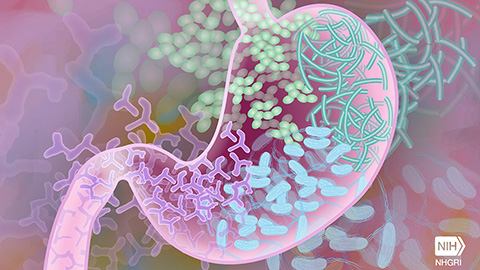Greener neighborhoods can protect us — at the molecular level
A new study finds that greenspace – the vegetation in a neighborhood’s yards, parks and public spaces – has a positive impact on a key genetic marker associated with exposure to stress. However, the study also finds that the positive impact of greenspace isn’t enough to compensate for other environmental challenges, such as air pollution.
The markers in question are telomeres, which are sections of repetitive DNA found at each end of a chromosome that serve to protect the ends of the chromosomes from damage. However, each time a cell divides, the telomeres inside those cells become slightly shorter. Once the telomeres become so short that the cell cannot divide successfully, the cell dies.

“This makes telomeres important markers of biological age, or how worn down our cells are,” says Scott Ogletree, corresponding author of a paper on the study and a former postdoctoral researcher at North Carolina State University’s Center for Geospatial Analytics. “And we know that many variables – such as stress – can influence how quickly our telomeres wear down.” Ogletree is now a lecturer at the University of Edinburgh.
“There’s a lot of research that talks about the various ways in which greenspace is beneficial, and a lot of research that talks about adverse health effects associated with pollution, racist segregation in housing, and other social and environmental challenges,” says Aaron Hipp, co-author of the study and a professor of parks, recreation and tourism management at NC State. “This study was an attempt to quantify the beneficial impacts of greenspace at the cellular level, and the extent to which greenspace can help to offset environmental harms.”
For the study, researchers drew on data from the CDC’s National Health and Nutrition Examination Survey (NHANES) for the years 1999-2002. NHANES is a longitudinal, nationally representative study that assesses the health of the U.S. population through interviews and physical examinations.
Specifically, the researchers looked at data on 7,827 people that allowed them to assess their demographic data, the length of their telomeres, and where they lived. The research team assessed the amount of greenspace in each person’s neighborhood and how that related to their telomere length. The researchers also accounted for potential confounding variables, such as lifestyle, health history and substance use. In addition, the researchers identified a suite of other environmental variables that could affect telomere length, such as air quality and “redlining” maps that track historically segregated neighborhoods.
“We found that the more greenspace people had in their neighborhoods, the longer their telomeres were,” says Hipp, who is also the associate director of social and behavioral science applications at NC State’s Center for Geospatial Analytics. “That was true regardless of race, economic status, whether they were drinkers or smokers, etc.”
“That’s the good news,” Ogletree says. “However, when we accounted for other characteristics of each neighborhood – air pollution, segregation, or ‘deprivation’ – the positive effect of the greenspace essentially disappeared. Deprivation, in this context, was an overarching variable that included the neighborhood-level data on income, education, employment status, and housing conditions. In other words, while greenspace seems to help protect telomere length, the harm from other factors appears to offset that protection.”
“Greenspace is tremendously valuable for a community, but it is not enough to overcome systemic racism and the effects of economic segregation and environmental justice challenges on its own,” says Hipp. “This study drives home the idea that creating greenspace in a community is important, but it’s as crucial – or more crucial – for us to address environmental harms, particularly those tied to systemic racism.”
This article was first published by North Carolina State University. Read the original.
Enjoy reading ASBMB Today?
Become a member to receive the print edition four times a year and the digital edition monthly.
Learn moreGet the latest from ASBMB Today
Enter your email address, and we’ll send you a weekly email with recent articles, interviews and more.
Latest in Science
Science highlights or most popular articles

Building the blueprint to block HIV
Wesley Sundquist will present his work on the HIV capsid and revolutionary drug, Lenacapavir, at the ASBMB Annual Meeting, March 7–10, in Maryland.

Gut microbes hijack cancer pathway in high-fat diets
Researchers at the Feinstein Institutes for Medical Research found that a high-fat diet increases ammonia-producing bacteria in the gut microbiome of mice, which in turn disrupts TGF-β signaling and promotes colorectal cancer.

Mapping fentanyl’s cellular footprint
Using a new imaging method, researchers at State University of New York at Buffalo traced fentanyl’s effects inside brain immune cells, revealing how the drug alters lipid droplets, pointing to new paths for addiction diagnostics.

Designing life’s building blocks with AI
Tanja Kortemme, a professor at the University of California, San Francisco, will discuss her research using computational biology to engineer proteins at the 2026 ASBMB Annual Meeting.

Cholesterol as a novel biomarker for Fragile X syndrome
Researchers in Quebec identified lower levels of a brain cholesterol metabolite, 24-hydroxycholesterol, in patients with fragile X syndrome, a finding that could provide a simple blood-based biomarker for understanding and managing the condition.

How lipid metabolism shapes sperm development
Researchers at Hokkaido University identify the enzyme behind a key lipid in sperm development. The findings reveal how seminolipids shape sperm formation and may inform future diagnostics and treatments for male infertility.

